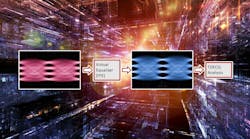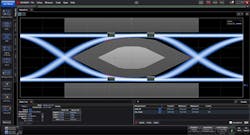Members can download this article in PDF format.
What you'll learn:
- Transmitter testing methods prior to TDECQ.
- Why TDECQ has overtaken TDP in PAM4 transmitter testing.
- Steps in the TDECQ measurement process.
- Using sampling oscilloscopes with built-in TDECQ.
Next-generation communications systems generally strive to achieve higher capacities than previous generations. Physical limitations of channel bandwidths led to the use of four-level amplitude modulation (PAM4) schemes rather than non-return-to-zero (NRZ) modulation for 400-Gb/s systems developed in the IEEE 802.3bs standard.
Bit-error-ratios (BER), typically better than 1e-12, could not be economically achieved using PAM4, thus requiring the use of forward error correction (FEC) to achieve the required frame-loss ratio for an Ethernet system. The use of FEC and PAM4 led to significant changes in how an optical transmitter is specified and tested.
Quantifying Optical Transmitter Quality
Historically, several parameters were used to quantify the quality of an optical transmitter. Extinction ratio (ER) indicates how well available laser power is converted to modulation power. Optical modulation amplitude (OMA) indicates the strength of the modulation power.
For legacy NRZ systems, eye-mask tests place polygons below, within, and above the NRZ eye diagram and verify where the transmitter signal may not exist (Fig. 1). It effectively regulates the minimum allowable opening of the eye diagram and prevents excessive overshoot and undershoot, harmful to a receiver.
Coupled with the OMA test, this then verifies a minimum separation between the logic one and logic zero levels, necessary for a receiver to make correct logic decisions. Unfortunately, none of these tests can provide a direct indication of the BER that will be achieved with the transmitter, as BER is the key system metric that must be satisfied.
A BER measurement isn’t generally performed directly on the signal from the transmitter. With no channel to attenuate the signal, there will likely be no errors generated if the BER of the signal from the transmitter is measured directly.
Transmitter Testing Before TDECQ
In earlier 10G and 100G standards, the effective BER performance of a transmitter is determined by comparing the transmitter being tested to an ideal reference transmitter. The reference transmitter is first connected through an optical attenuator to an optical-to electrical converter (O/E) attached to the BER tester (BERT).
A key attribute of a BERT is that it observes every symbol in the input data stream and does so at the baud rate of the transmitter. It’s then the only instrument that can make a direct assessment of transmitter performance to probabilities in the 1e-12 range. Other instruments, like oscilloscopes, can only make estimates of low BER performance.
For the transmitter test, the reference transmitter signal into the BERT is attenuated until a target BER is observed, perhaps 1e-12. The power into the O/E is documented. The reference transmitter is replaced with the transmitter being tested, with a typical optical channel/fiber placed between the transmitter and BERT. The variable attenuation is then adjusted until the same BER as was observed with the reference transmitter is observed again.
The power level into the O/E is compared to the previously measured power when the reference transmitter was used. The ratio of the two measured power levels, in decibels, is the “transmitter and dispersion penalty” (TDP) of the transmitter under test (Fig. 2). Essentially, it’s an indication of how much extra power is required, compared to the reference transmitter, to achieve the target BER.
Unlike the eye-mask test, TDP does provide an accurate relative assessment, in terms of BER, of the quality of a transmitter in the context of how well it will operate in a communications system. However, the TDP process does have some issues.
For one, BER measurements generally take a long time to perform due to the requirement to observe large numbers of transmitted symbols to verify BER to low probabilities. And the TDP test system is somewhat complicated to set up and expensive to configure. The switch to PAM4 schemes provided an opportunity to take a fresh look at how optical transmitter performance is defined and tested.
As mentioned earlier, FEC will be used to compensate for the inability of the PAM4 hardware link to achieve low BER levels. A key point to consider is that if the uncorrected BER is allowed to be high, then the optical transmitter tests don’t need to exclusively employ test techniques that measure BER to low probabilities.
An oscilloscope can be considered in addition to, or even in place of, a BERT. This is important because oscilloscopes are already required for the ER and OMA measurements, providing an opportunity for a lower overall test system cost (with some modifications for PAM4 discussed later).
TDECQ Supplants TDP as the Optimal PAM4 Transmitter Test
Transmitter dispersion and eye closure quaternary (TDECQ) has been developed for PAM4 transmitters as a metric that’s like the TDP test described above. It’s intended to determine the additional power that’s required for a transmitter to achieve the symbol error ratio (SER) compared to an ideal reference transmitter. SER is used rather than BER, as each PAM4 symbol represents two bits.
Two important differences exist between TDP and TDECQ. Rather than use a physical-reference transmitter, a virtual-reference transmitter is mathematically created based on the measured OMA of the transmitter under test. Also, receiver equalization will be employed to overcome the significant impairments of the overall system. In addition to a virtual-reference transmitter, a virtual equalizer is used in the TDECQ test to emulate operation of the receiver used in the actual communications system.
The TDECQ measurement process is as follows:
- A specific “Short Stress Pattern Random Quaternary” (SSPRQ) data pattern is sent through the transmitter. The SSPRQ pattern is intended to have stress similar to random data, but with an overall pattern length of 2^16-1.
- One entire pattern length waveform is captured by the oscilloscope.
- The OMA is determined from the waveform.
- The waveform record is “aggregated” to create a PAM4 eye diagram.
- Vertical histograms are constructed to determine the “spread” or eye closure at each of the four levels of the measured signal, both slightly early and late of the time center of the eye.
- A virtual ideal PAM4 eye diagram is also constructed having the same OMA as the measured signal.
- Random noise is mathematically added to the PAM4 eye of the virtual ideal transmitter signal until the maximum-allowed SER, determined mathematically with a virtual receiver, is achieved.
- The captured signal from the transmitter under test is passed through a virtual feed-forward equalizer.
- Random noise is also mathematically added to the equalized signal of the transmitter under test to reach the target SER.
- TDECQ is the ratio of the noise added to the ideal signal to the noise added to the measured/equalized signal.
- The virtual equalizer tap settings are adjusted to maximize the eye opening and minimize the TDECQ metric.
- Noise is added to the equalized signal to reach the target SER. Equalizer tap settings are adjusted iteratively until the maximum added noise that results in the target SER is determined. This should yield the minimum TDECQ penalty.
Consider if the measured transmitter signal was ideal and had no eye closure. The noise that could be added to it to observe the SER target would be the same as the noise added to the ideal reference signal. The TDECQ ratio would be 1 (0 dB), indicating that the power penalty (the extra signal required to perform as well as the reference signal) would be zero.
Conversely a poor-quality signal would only tolerate a small amount of added noise to reach the target SER, the TDECQ ratio would be large (indicative of a large penalty value), and extra power at the receiver would be required to achieve the target SER.
With the exception of the virtual equalization used, the TDECQ power penalty should be analogous to the TDP power penalty. TDECQ adds noise to observe the receiver sensitivity threshold at the target SER, while TDP uses signal attenuation to reach the receiver sensitivity threshold at the target BER.
Quick TDECQ Implementation with Sampling Scopes
Although the mathematics and measurement process to determine TDECQ are complex, the actual implementation of the measurement is surprisingly simple and can be performed in a short amount of time. Sampling oscilloscopes, commonly known as DCAs, have built-in TDECQ analysis to simplify the measurement process.
The waveform is “pattern locked” so that the complete continuous waveform record can be captured. The requirement for pattern locking led to the development of the SSPRQ pattern. This pattern, which is 2^16-1 in length, is easy to pattern lock to. However, it includes the stress sequences found in the PRBS31 (2^31-1 in length and difficult to pattern lock to). Signals are displayed as PAM4 eye diagrams.
The waveform is passed through a special TDECQ virtual equalizer that’s built into the oscilloscope. The TDECQ measurement is selected and applied to the equalized signal and then the TDECQ value is computed and reported.
In the transmitter used in Figure 3, significant eye opening is achieved through the virtual equalization (the red unequalized signal has a TDECQ in excess of 5 dB). Extinction ratio and OMA are also performed on the PAM4 transmitter, but with some significant changes compared to an NRZ transmitter. For the NRZ signal, the one and zero levels from the aggregated eye diagram are used to compute these values. For the PAM4 signal, extinction ratio and OMA are computed from the zero and three levels.
The zero level is from a specific sequence of consecutive logic zeroes, and the logic three level from a specific sequence of consecutive logic threes. This means that like TDECQ, the oscilloscope must be pattern locked to perform the measurement.
The TDECQ, outer extinction ratio, and outer OMA tests can all be performed using just one waveform acquired by the oscilloscope. This is a nice convenience for R&D testing, but essential for manufacturing tests, where test time must be kept low using a high throughput test process.
Consequently, it should help alleviate concerns that testing PAM4 transceivers will be more difficult and expensive compared to legacy NRZ transmitters. In fact, the time it takes to verify waveform compliance, including acquiring and analyzing the signal, is less than five seconds, substantially faster than the typical time required to test a legacy NRZ transmitter.
Validating TDECQ in a Real System
Does the TDECQ method really work? The simplest way to answer that question is to verify the results in a real system. Recall that the intent of the measurement is to determine the system penalty due to dispersion and eye closure. If two transmitters are measured, and one has a TDECQ of 1.7 dB, and a second has a TDECQ of 2.9 dB, we would expect that when these transmitters are used in a real system, the receiver sensitivity would be 1.2 dB higher/better for the first transmitter compared to the second (Fig. 4).
It's important to note that good correlation between TDECQ and actual receiver sensitivity is achieved when the real system receiver is accurately emulated by the virtual receiver used in the TDECQ analysis. If the real system receiver is different (e.g., has a more powerful equalizer), it’s reasonable to expect that the TDECQ analysis could be pessimistic, predicting higher system power penalties than actually occur in the real system.
Virtually every optical communication standard that employs PAM4 transmission has adopted TDECQ as the primary metric for specifying transmitter quality. TDEC is similar to TDECQ, but it’s used for NRZ signals and now applied to new NRZ systems, including 50G PON. New standards being developed, including 800G and 1.6T systems, will use TDECQ, but there may be modifications to better emulate changes and improvements in receiver technology.
References
“TDECQ (Transmitter Dispersion Eye Closure Quaternary) Replaces Historic Eye-mask and TDP Test for 400 Gb/s PAM4 Optical Transmitters,” King, Leyba, LeCheminant, OFC 2017.
“New Metric Offers More Accurate Estimate of Optical Transmitter’s Impact on Multimode Fiber-optic Links,” LeCheminant, Dawe, Petrilla, DesignCon 2015.
“BER and TDECQ Correlation for Different Impairments in 400Gbps PAM4 system,” Zhao, Doerr, Chen, Zhu, Ton, Aroca, Huang and Xu, OFC 2020.





